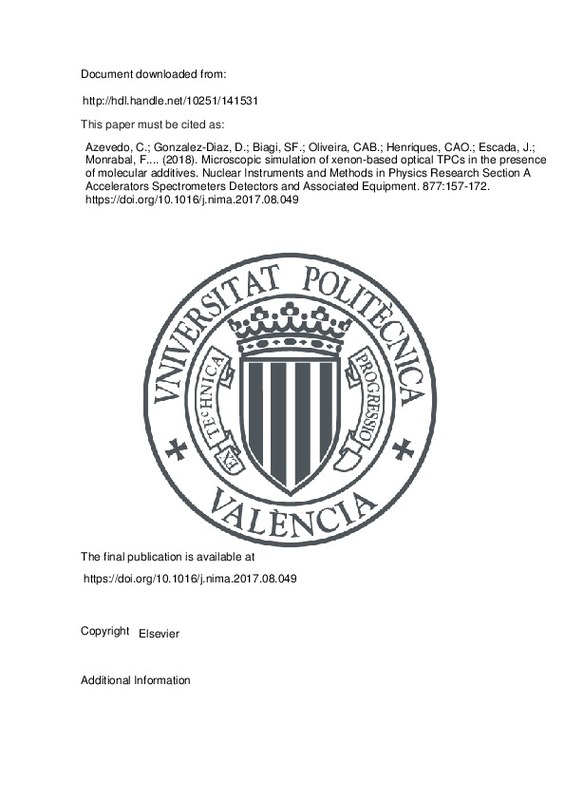Azevedo, C.; Gonzalez-Diaz, D.; Biagi, SF.; Oliveira, CAB.; Henriques, CAO.; Escada, J.; Monrabal, F.... (2018). Microscopic simulation of xenon-based optical TPCs in the presence of molecular additives. Nuclear Instruments and Methods in Physics Research Section A Accelerators Spectrometers Detectors and Associated Equipment. 877:157-172. https://doi.org/10.1016/j.nima.2017.08.049
Por favor, use este identificador para citar o enlazar este ítem: http://hdl.handle.net/10251/141531
|
Título:
|
Microscopic simulation of xenon-based optical TPCs in the presence of molecular additives
|
|
Autor:
|
Azevedo, C.D.R.
Gonzalez-Diaz, D.
Biagi, S. F.
Oliveira, C. A. B.
Henriques, C. A. O.
Escada, J.
Monrabal, F.
Gomez-Cadenas, J. J.

 Álvarez-Puerta, Vicente
Alvarez, V.
Álvarez-Puerta, Vicente
Alvarez, V.

 Esteve Bosch, Raul
Esteve Bosch, Raul

 Herrero Bosch, Vicente
Herrero Bosch, Vicente

 Mora Mas, Francisco José
Querol-Segura, Marc
Rodriguez-Samaniego, Javier
Mora Mas, Francisco José
Querol-Segura, Marc
Rodriguez-Samaniego, Javier

 Toledo Alarcón, José Francisco
Toledo Alarcón, José Francisco
|
|
Entidad UPV:
|
Universitat Politècnica de València. Departamento de Ingeniería Electrónica - Departament d'Enginyeria Electrònica
Universitat Politècnica de València. Instituto de Instrumentación para Imagen Molecular - Institut d'Instrumentació per a Imatge Molecular
|
|
Fecha difusión:
|
|
|
Resumen:
|
[EN] We introduce a simulation framework for the transport of high and low energy electrons in xenon-based optical time projection chambers (OTPCs). The simulation relies on elementary cross sections (electron-atom and ...[+]
[EN] We introduce a simulation framework for the transport of high and low energy electrons in xenon-based optical time projection chambers (OTPCs). The simulation relies on elementary cross sections (electron-atom and electron-molecule) and incorporates, in order to compute the gas scintillation, the reaction/quenching rates (atom-atom and atom-molecule) of the first 41 excited
states of xenon and the relevant associated excimers, together with their radiative cascade. The results compare positively with observations made in pure xenon and its mixtures with CO2 and CF4 in a range of pressures from 0.1 to 10 bar. This work sheds some light on the elementary processes responsible for the primary and secondary xenon-scintillation mechanisms in the presence
of additives, that are of interest to the OTPC technology.
[-]
|
|
Palabras clave:
|
Optical TPCs
,
Microscopic simulation
,
Xenon scintillation
,
High pressure
,
Gaseous electronics
,
Molecular additives
,
Molecular quenchers
,
Electron cooling
|
|
Derechos de uso:
|
Reconocimiento - No comercial - Sin obra derivada (by-nc-nd)
|
|
Fuente:
|
Nuclear Instruments and Methods in Physics Research Section A Accelerators Spectrometers Detectors and Associated Equipment. (issn:
0168-9002
)
|
|
DOI:
|
10.1016/j.nima.2017.08.049
|
|
Editorial:
|
Elsevier
|
|
Versión del editor:
|
https://doi.org/10.1016/j.nima.2017.08.049
|
|
Código del Proyecto:
|
info:eu-repo/grantAgreement/EC/FP7/339787/EU/Towards the NEXT generation of bb0nu experimets/
...[+]
info:eu-repo/grantAgreement/EC/FP7/339787/EU/Towards the NEXT generation of bb0nu experimets/
info:eu-repo/grantAgreement/DOE//DE-AC02-07CH11359/
info:eu-repo/grantAgreement/DOE//DE-FG02-13ER42020/
info:eu-repo/grantAgreement/FCT/UID/UID%2FFIS%2F04559%2F2013/PT/
info:eu-repo/grantAgreement/MINECO//SEV-2014-0398/ES/INSTITUTO DE FISICA CORPUSCULAR (IFIC)/
info:eu-repo/grantAgreement/FCT/PTDC/PTDC%2FFIS-NUC%2F2525%2F2014/PT/
info:eu-repo/grantAgreement/GVA//PROMETEO%2F2016%2F120/
info:eu-repo/grantAgreement/MINECO//RYC-2015-18820/ES/RYC-2015-18820/
[-]
|
|
Agradecimientos:
|
DGD is supported by the Ramon y Cajal program (Spain) under contract number RYC-2015-18820. The authors want to acknowledge the RD51 collaboration for encouragement and support during the elaboration of this work, and in ...[+]
DGD is supported by the Ramon y Cajal program (Spain) under contract number RYC-2015-18820. The authors want to acknowledge the RD51 collaboration for encouragement and support during the elaboration of this work, and in particular discussions with F. Resnati, A. Milov, V. Peskov, M. Suzuki and A. F. Borghesani.
The NEXT Collaboration acknowledges support from the following agencies and institutions: the European Research Council (ERC) under the Advanced Grant 339787-NEXT; the Ministerio de Economia y Competitividad of Spain under grants FIS2014-53371-C04 and the Severo Ochoa Program SEV-2014-0398; the GVA of Spain under grant PROM-ETEO/2016/120; the Portuguese FCT and FEDER through the program COMPETE, project PTDC/FIS-NUC/2525/2014 and UID/FIS/04559/2013; the U.S. Department of Energy under contracts number DE-AC02-07CH11359 (Fermi National Accelerator Laboratory) and DE-FG02-13ER42020 (Texas A& and the University of Texas at Arlington.
[-]
|
|
Tipo:
|
Artículo
|







![[Cerrado]](/themes/UPV/images/candado.png)


